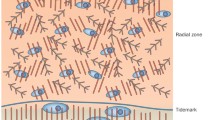Abstract
Chondrocytes are imbedded in an avascular, highly charged extracellular matrix which could form a barrier to the transfer of dietary essential fatty acids (EFA) to chondrocytes. A study was designed to assess the composition of immature and mature joint cartilage with respect to essential and nonessential fatty acids relevant to EFA deficiency. Cartilage and muscle samples were obtained from human fetus, infant and adult cadavers, and from fetal and mature sheep. Lipid extracts were prepared and the fatty acid composition determined. In human and sheep joint cartilage, linoleic acid (LA; 18∶2n−6) content was lower, and n−9 eicosatrienoic acid (ETrA; 20∶3n−9) and arachidonic acid (AA; 20∶4n−6) were higher in fetuses compared to mature subjects. An intermediate pattern was seen in infant cartilage. n−3 Fatty acids tended to be higher in fetal than in mature cartilage in humans and in sheep. In human muscle (and in other noncartilaginous comparison tissues), similar differences between fetuses and adults were seen in LA and AA, but not in ETrA. In fetal sheep muscle, very low LA, reduced AA and raised ETrA levels compared to mature sheep muscle were seen. However, although the pattern is characteristic of EFA deficiency, the abundance of n−6 EFA in liver and spleen of human fetuses and of n−3 EFA in liver and spleen of fetal sheep suggests that placental transfer of EFA is not likely to be limiting. During fetal development, the metabolism of fatty acids is distinctive and differs between the species. ETrA appears to be a readily measurable component of some tissues at certain stages of development when its presence in tissues does not indicate EFA deficiency.
Similar content being viewed by others
Abbreviations
- AA:
-
arachidonic acid (20∶4n−6)
- EFA:
-
essential fatty acid
- ETrA:
-
eicosatrienoic acid (20∶3n−9)
- LA:
-
linoleic acid (18∶2n−6)
- OA:
-
oleic acid (18∶1n−9)
- SIDS:
-
sudden infant death syndrome
References
Simopoulos, A.P. (1991) Omega-3 Fatty Acids in Health and Disease and in Growth and Development,Am. J. Clin. Nutr. 54, 438–463.
Pudelkewicz, C., Seufert, J., and Holman, R.T. (1968) Requirements of the Female Rat for Linoleic and Linolenic Acids,J. Nutr. 94, 138–146.
Brenner, R.R., and Peluffo, R.O. (1966) Effect of Saturated and Unsaturated Fatty Acids on the Desaturationin vitro of Palmitic, Stearic, Oleic, Linoleic and Linolenic Acids,J. Biol. Chem. 241, 5213–5219.
Holman, R.T. (1977) Essential Fatty Acid Deficiency in Humans, inHandbook of Nutrition and Foods (Recheigle, M., ed.) CRC Press, Cleveland.
Adkisson, H.D., Risener, F.S., Zarrinkar, P.P., Walla, M.D., Christie, W.W., and Wuthier, R.E. (1991) Unique Fatty Acid Composition of Normal Cartilage: Discovery of High Levels of n−9 Eicosatrienoic Acid and Low Levels of n−6 Polyunsaturated Fatty Acids,FASEB J. 5, 344–353.
Adkisson, H.D., Trancik, T.M., Zarrinkar, P.P., and Wuthier, R.E. (1990) Accumulation of Essential Fatty Acids in Hyaline Cartilage with Aging and Joint Disease: Possible Implications in Development of Osteoarthritis,Orthopaedic Trans. 14, 423–424.
Kemick, M.L.S., Chin, J.E., and Wuthier, R.E. (1989) Role of Prostaglandins in Differentiation of Growth Plate Chondrocytes,Adv. Prostaglandin Thromboxone Leukotriene Res. 18, 423–426.
Stenson, W.F., Prescott, S.M., and Sprecher, H. (1984) Leukotriene B Formation by Neutrophils from Essential Fatty Acid-Deficient Rats,J. Biol. Chem. 259, 11784–11789.
Mizuno, K., Yamamoto, S., and Lands, W.E.M. (1982) Effects of Nonsteroidal Anti-Inflammatory Drugs on Fatty Acid Cyclo-oxygenase and Prostaglandin Hydroperoxidase Activities,Prostaglandins 23, 734–757.
Collins, D.H. (1949) Osteoarthritis, inThe Pathology of Articular and Spinal Diseases, pp. 76–81, Edward Arnold, London.
Xu, H., Watkins B.A., and Adkisson, H.D. (1994) Dietary Lipids Modify the Fatty Acid Composition of Cartilage, Isolated Chondrocytes and Matrix Vesicles,Lipids 29, 619–625.
Author information
Authors and Affiliations
About this article
Cite this article
Cleland, K.A., James, M.J., Neumann, M.A. et al. Differences in fatty acid composition of immature and mature articular cartilage in humans and sheep. Lipids 30, 949–953 (1995). https://doi.org/10.1007/BF02537487
Received:
Revised:
Accepted:
Issue Date:
DOI: https://doi.org/10.1007/BF02537487




